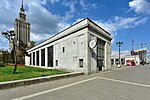Palace of Culture and Science

The Palace of Culture and Science (Polish: Pałac Kultury i Nauki; abbreviated PKiN) is a notable high-rise building in central Warsaw, Poland. With a total height of 237 metres (778 ft) it is the second tallest building in both Warsaw and Poland after Varso, the 6th-tallest building in the European Union (including spire) and one of the tallest on the European continent. Constructed in 1955, it houses various public and cultural institutions such as cinemas, theatres, libraries, sports clubs, university faculties, and authorities of the Polish Academy of Sciences. Since 2007, it has been enlisted in the Registry of Objects of Cultural Heritage. Motivated by Polish historical architecture and American art deco high-rise buildings, the PKiN was designed by Soviet Russian architect Lev Rudnev in "Seven Sisters" style and is informally referred to as the Eighth Sister. The Palace was also the tallest clock tower in the world until the installation of a clock mechanism on the NTT Docomo Yoyogi Building in Tokyo, Japan.
Excerpt from the Wikipedia article Palace of Culture and Science (License: CC BY-SA 3.0, Authors, Images).Palace of Culture and Science
Plac Defilad, Warsaw Śródmieście (Warsaw)
Geographical coordinates (GPS) Address Website External links Nearby Places Show on map
Geographical coordinates (GPS)
| Latitude | Longitude |
|---|---|
| N 52.231666666667 ° | E 21.006388888889 ° |
Address
Pałac Kultury
Plac Defilad 1
00-110 Warsaw, Śródmieście (Warsaw)
Masovian Voivodeship, Poland
Open on Google Maps










